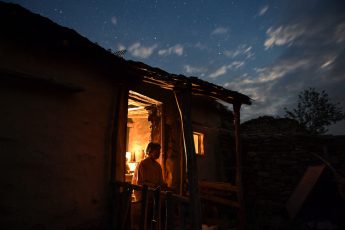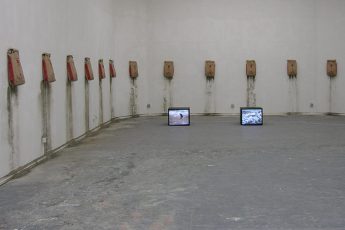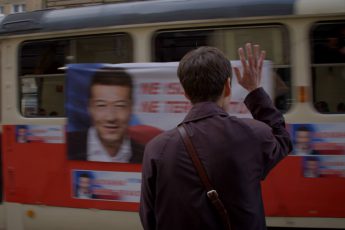Stranger Danger
Anka and Wilhelm Sasnal’s The Sun, the Sun Blinded Me (2016)
Vol. 68 (October 2016) by Jack Page
Inspired by both Albert Camus’ novel The Stranger and a grim fairy tale entitled Shadow by Hans Christian Anderson, the Sasnals weave an insidiously political thread hidden beneath a poetically executed narrative. The artistry inherent in their style of filmmaking is comfortably suited to the allegorical delivery of themes, almost falling into the realms of the hallucinatory. The result is a pitch perfect meditation on issues relating to racism, xenophobia and identity.
Rafal Mackowiak plays the film’s protagonist with a calculated vacuity. The sparse decoration of his home seems to mirror his internal emptiness. A mattress is splayed across the floor, wires scattered all over the bedroom. A dull grayness seems to engulf the interior aesthetic of his flat. Rafal’s solitary existence soon becomes apparent as he lives out his days in a protective routine, constantly running, avoiding public transport and therefore the nuisance that is other people. He is disassociated from the bothersome society that surrounds him in his building from the outset of the film. Different in age, costume and temperament, Rafal bounds up and down the staircase, rushing past the grumpy, senile residents who quarrel maliciously on the steps.
Rafal’s subjective point of view of the world is adopted by the camera, closely aligned with his perspective, offering the same imposing impression the outside world has on him to the audience. In one scene, Rafal tries to enjoy some lunch outside of a quiet restaurant, when a passerby in the midst of a dramatic phone call joins him at his table, uninvited. Rafal’s appetite is immediately spoiled by the man’s presence as he has a sudden sorrowful outburst. The man’s pathetic public display of emotion strikes Rafal as rude; he breathes a sigh of relief when the man finally leaves. This encounter uses the juxtaposition to further disenfranchise Rafal from the rest of society. The contrasting degrees of expression between himself and the man on the phone illustrate not only his animosity and disdain for other human beings, but also his lack of compassion.
Rafal’s reproachfulness of others is rationalized by the intentionally aggravating performance of characters, such as the vicar and his own girlfriend. During a ride to the beach, Rafal’s girlfriend vulgarly chews on gum. Rafal furtively runs his fingers through his hair in an attempt to hide his frustration. A close up on his eyes, however, reveals a blatant scowl. Similarly, in a sequence that excludes Rafal from the frame and the setting altogether, a portly vicar is squeezed into the frame from a low angle. He lounges in his chair, oafishly spinning from side to side with stains on his underwear and a bulge clearly visible at his crotch. He greedily stuffs bread and cheese into his mouth, gulping without chewing while breathing with an uncomfortable heaviness. In the next scene, the vicar is shown in full regalia, marching and singing with an air of sincere professionalism. Although, all this pomp and circumstance is entirely undermined by the candid scene prior, with its absurdly fatuous embodiment of the vicar and – I believe – the clergy in general.
The film criticizes the frivolousness of religious ceremony on a number of occasions, but none more so than at Rafal’s mother’s funeral. Dressed in a casual outfit, Rafal fails to signs of grief or interest. He chooses not to assist in the burial of the casket, is absent from the photographs taken, and struggles to stay awake at the ceremony. Yawning, bored and restless, he squirms in his chair. The praying visitors, on the other hand, are dressed in appropriate suits and gowns, weeping and chanting until their irksome words become monotonous and unsynchronized. These disembodied prayers for the dead are met with silent contempt from Rafal, who longs to be outside exercising instead.
At a BBQ with some acquaintances – it would be farfetched to say they are friends – Rafal sits still, drinking in silence as the group bickers about the problematic situation of immigrants in Poland. Their crass conversation turns into a shared, bigoted opinion of both black and Ukrainian cultures. They tell exploitative jokes fueled by racial stereotyping, expressing fears of contracting Ebola or acts of terrorism. The scene crystallizes the unlikable and offensive nature of others and their strangeness, justifying Rafal’s wilful avoidance of the rest of the world. But when he stumbles across an Arab stranger washed up on the beach, he bludgeons him to death. For the rest of the film’s runtime, a vision of the Arab seems to shadow Rafal. Interestingly, Rafal is finally convicted of murder not because of his actions but because of his behavior. What frightens the Polish witnesses is his inhuman lack of remorse, instead of the more worrying actualization of a hate crime. Rafal’s motive for killing the Arab is non-existent. The act itself should be taken as a figurative rather than literal even, clearly intended as a narrative device to trigger the court scenes and the jury’s verdict. Their conclusion is an abstract indictment of the political tension rife in Poland and the country’s refusal to accept refugees. If other nations follow suit then the rest of Europe is at risk of becoming strangers as well.




Leave a Comment